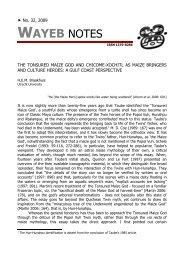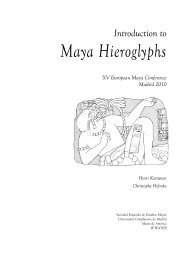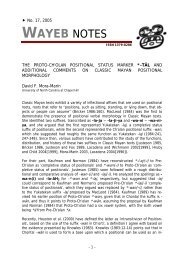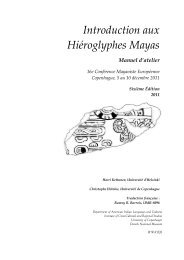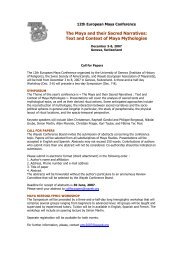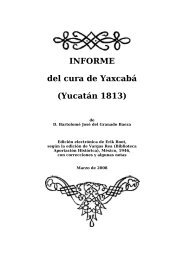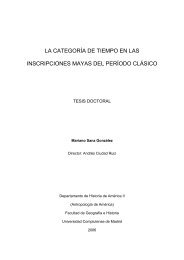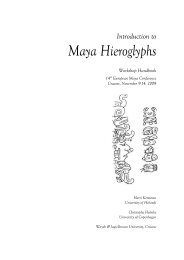Introduction to Maya Hieroglyphs - Wayeb
Introduction to Maya Hieroglyphs - Wayeb
Introduction to Maya Hieroglyphs - Wayeb
You also want an ePaper? Increase the reach of your titles
YUMPU automatically turns print PDFs into web optimized ePapers that Google loves.
Kettunen & Helmke 2011<br />
Glossary of Linguistic Terminology<br />
lexical ambiguity<br />
A type of ambiguity that arises when a word has multiple meanings. The <strong>Maya</strong> word chan (sky, four, snake) is<br />
often cited as an instance of lexical ambiguity. See also HOMOPHONE.<br />
mediopassive<br />
A VOICE that is used in certain languages like Latin, Ancient Greek, and in the <strong>Maya</strong> languages. In the<br />
mediopassive voice (middle voice), the agent is completely deleted and is <strong>to</strong> be unders<strong>to</strong>od only in general terms<br />
or not at all. Instead, the PATIENT becomes the SUBJECT of the verb. In the mediopassive voice the action of the<br />
subject is directed <strong>to</strong>wards the subject itself; e.g. (in Classic <strong>Maya</strong>): chukuuy Aj Ukul (“Aj Ukul got captured”).<br />
metaphor<br />
A figurative expression which is not <strong>to</strong> be unders<strong>to</strong>od literally (but which refers <strong>to</strong> certain conceptual similarity),<br />
i.e. a metaphor employs an altered but similar concept <strong>to</strong> another concept or idea, e.g: “At this point I’m really<br />
drained and burned up trying <strong>to</strong> absorb linguistic data”.<br />
me<strong>to</strong>nymy<br />
A routine in which one word (that is an attribute of another, more complex or an abstract word) is used <strong>to</strong> stand<br />
for another word or concept. For example, in the phrase “The pen is mightier than the sword” pen and sword<br />
represent writing/publishing and war/military force/violence, respectively. In a same manner, the word crown can<br />
refer <strong>to</strong> monarchy or <strong>to</strong> the royal house (a concept that has me<strong>to</strong>nymic attributes as well) and window table can<br />
refer <strong>to</strong> the cus<strong>to</strong>mers seated on a window table.<br />
minimal pair<br />
A set of two words or other structures which differ in meaning and which have only one difference in their<br />
sounds. See CONTRAST for further information.<br />
mood<br />
A cover term for one of the four INFLECTIONAL categories of VERBS (mood, TENSE, ASPECT, and modality). The most<br />
common categories are: indicative (statement), imperative (command), optative (wish), etc. It seems at present<br />
that the only mood in the <strong>Maya</strong> hieroglyphic texts is that of indicative.<br />
morpheme<br />
The smallest meaning-bearing unit (minimal grammatical unit), i.e. a word or a part of a word that cannot be<br />
divided in<strong>to</strong> smaller meaning-bearing forms. Morphemes are generally either ROOTS or AFFIXES. For example, the<br />
word “in<strong>to</strong>xicated” has four morphemes: the prefix “in-“, the root “<strong>to</strong>xic”, and the suffixes “-ate” and “-ed”. A<br />
Classic <strong>Maya</strong> glyphic example of chu-ka-ja produces a transcription of chu[h]kaj which can be divided in<strong>to</strong> four<br />
morphemes: chu[-h]k-aj-Ø (chuk: <strong>to</strong> seize; -h-: passive marker of CVC transitive verbs; -aj: thematic suffix; and –Ø:<br />
third person absolutive pronoun [sign “Ø” represents a “ZERO MORPHEME”]).<br />
morphology<br />
A subfield in linguistics that is involved in the study of MORPHEMES, or the internal structure of words.<br />
morphophonemic<br />
Relating <strong>to</strong> the change of one PHONEME <strong>to</strong> another in particular surroundings. The presence of morphophonemic<br />
constructions (morphosyllables) in the <strong>Maya</strong> hieroglyphic writing system is still debatable. In this volume<br />
morphosyllables are not considered part of the description of the <strong>Maya</strong> writing system (as reconstructions<br />
presently favored by the European school of <strong>Maya</strong> epigraphers are an equally viable solution <strong>to</strong> the variant<br />
137/154



